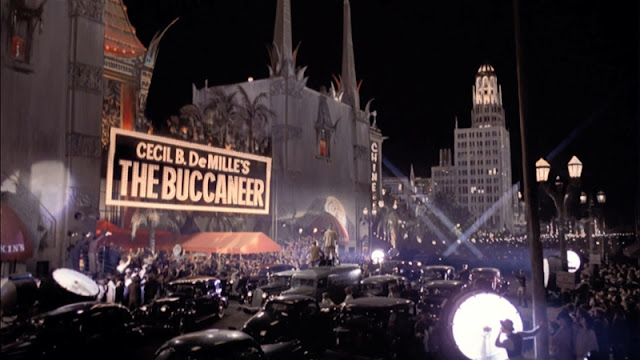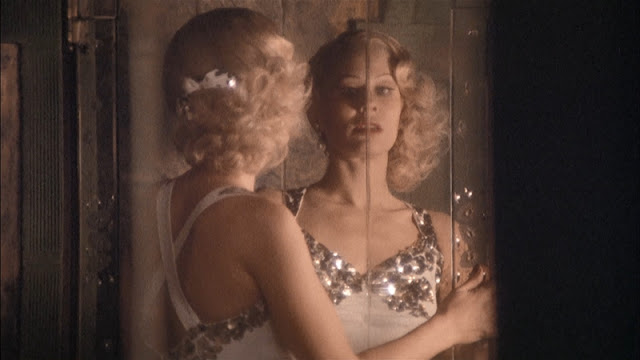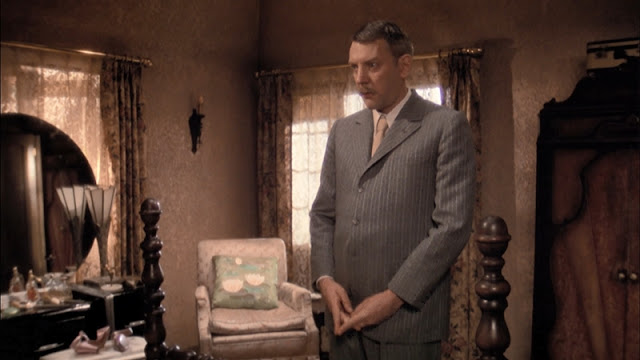(1975) Directed by John Schlesinger; Written by Waldo Salt; Based on the novel by Nathanael West; Starring: Donald Sutherland, Karen Black, William Atherton, Burgess Meredith, Geraldine Page, Richard Dysart and Billy Barty; Available on Blu-ray and DVD
Rating: ****½
Big thanks to Paul from Silver Screen Classics for hosting
the Classic Literature on Film Blogathon.
Be sure to check out all the posts from this exceptional blogging event!
“When I saw the first cut of the film, I knew it was going to be controversial, but I was very proud of it – and still am, incidentally. I realized that maybe the casting of Karen Black as Faye was fatal, but I felt that we had a really interesting and extraordinary film which by no means was going to be popular.” – John Schlesinger (from 1978 interview, “I Both Hate and Love What I Do”: An interview with John Schlesinger, by Michael M. Riley)
“The central vision of the novel (The Day of the Locust),
‘The Burning of Los Angeles,’ comes from a poem that West wrote in 1932…My view
was much more directly political. I saw Hollywood as the center of propaganda
for the great American dream.” – Waldo Salt (from 1973 interview with Tom
Buckley, The New York Times)
Hollywood success stories are the myth that keeps packing audiences in the theater. Movie-goers seem to have an insatiable appetite for stories about someone down on their luck (often depicted by a plucky heroine) who suddenly makes it big. A Hollywood failure story is something else. Directed by John Schlesinger (Midnight Cowboy), and written by Waldo Salt (adapted from Nathaniel West’s short novel), The Day of the Locust strips back the glossy Tinsel Town veneer, to reveal its true, unglamorous nature. It begins with the Hollywood dream, before abruptly devolving into a nightmare. Amidst a few bright spots, the cast of characters is predominately an assortment of has-beens, hopefuls, and never-weres.
Tod Hackett (William Atherton) is a promising young artist working on the bottom rung of the motion picture business, circa 1938. He lives in a rundown apartment building, The San Bernardino Arms (“The San Berdoo”), populated by a host of characters involved directly or tangentially to show business. He’s obsessed by his neighbor, would-be starlet Faye Greener (Karen Black), who lives with her elderly, ex-Vaudevillian father Harry (Burgess Meredith). She regards him as a friend, but he desperately wants their relationship to be more than that. Another frequent visitor of the San Berdoo is quick-tempered Abe Kusich (Billy Barty), a little-person actor turned part-time hustler.
As Faye Greener, Karen Black* encapsulates the tone of the picture – a glamorous exterior that belies the ugliness underneath. In West’s book, Faye was only 17. The fact that Black was twice her character’s age only makes her character more pathetic. Faye (sporting a Harlow-esque platinum blonde hairdo) dreams of superstardom, taking the odd extra and bit parts in the hopes of landing her big break. In the meantime, she’s prepared to live a lifestyle beyond her means, and doesn’t care who she has to step on in the process. She’s the textbook definition of a self-dramatist, never missing an opportunity to hog the spotlight from everyone in her vicinity. Faye speaks with the affectations and ersatz sophistication of someone who can only mimic the celebrities she idolizes. She’s acts as if she’s constantly on stage, to the point where we never know who the real Faye is. Her syrupy sweet façade frequently lapses with moments of rage and abject cruelty. While she toys with Tod’s affections, she finds a willing mark in naïve Midwest transplant Homer Simpson (Donald Sutherland).
* Fun Fact #1: Schlesinger auditioned several actresses for
the role of Faye, including Raquel Welch, before eventually deciding on Karen
Black. According to the director, he chose Black because, “There’s something
about Karen Black, excellent actress though she is, that convinces you she
wouldn’t succeed.”
Donald Sutherland intrigues and repels as the perpetually bewildered Homer Simpson,*/**/*** a man who seems profoundly uncomfortable in his own skin. One of Homer’s trademark behaviors (which Sutherland perfectly replicated from the book) is that he can’t seem to control his fidgeting hands. If his hands are in a continual state of motion, Homer himself appears to be frozen in a state of indecision and unfulfilled longing (In his first attempt to win Faye’s favors, he drops a bouquet and runs). While he regards Faye with unconditional adoration, to her, he’s only a meal ticket – one in a long line of people she’s used and discarded. Homer proves that everyone, however, has their boiling point. When he finally snaps, 40 years of repressed desires and rage are released in one terrible display.
* Fun Fact #2: Was Nathanael West’s Homer the inspiration for the eponymous patriarch of The Simpsons television show? Its creator, Matt Groening, provided conflicting views, first attributing the character to his father, before conceding that Homer Simpson was in fact derived from West’s book. Which story is true? The world may never know.
** Fun Fact #3: Sutherland stated that it was “one of my favorite roles, because I played him exactly as I was, aged 13.” (2005 Guardian interview by John Patterson)
*** Fun Fact #4: In order to look the part of his oversized
character, the 6’ 4” Sutherland gained 40 pounds.
The Day of the Locust lays bare the wide chasm between the haves and have-nots. Amidst the established Hollywood royalty, everyone else is chasing the elusive dream of fame, or gasping on the fumes of their former lives. One of the few success stories in the film is wealthy screenwriter Claude Estee (Richard Dysart), who stages elaborate parties at his sprawling estate.* On the other end of the spectrum is Faye’s father Harry (Burgess Meredith), a one-time star of the stage and screen, is now reduced to peddling his homemade shoe polish door-to-door, performing his song and dance routine to anyone who pays attention. Much like his daughter, his behaviors are little more than an elaborate ruse. Further down the stepladder of fame are fringe dwellers Earle Shoop (Bo Hopkins), and Miguel (Pepe Serna), who stage cockfights for small-time stakes.
* Fun Fact #5: If Claude’s mansion looks familiar, it’s none
other than Frank Lloyd Wright’s “Mayan House,” which famously appeared in The
House on Haunted Hill (1959).
The film underscores the human cost of motion picture production. In one scene depicting the Battle of Waterloo,* the elaborate set collapses, resulting in multiple injuries. The producer’s reaction, much to Tod’s dismay, is to sweep it under the rug and move on. Human life, especially the lives of extras, is especially cheap. The film’s climax, set during a gala Chinese Theatre premiere, contains visuals worthy of a horror movie, when the mass of fans quickly becomes a mob. The crowd that arrived to feed off the fame of celebrities turns against itself, thirsting for blood and destruction. The scene reaches an apocalyptic crescendo with Hollywood literally in flames, mimicking Tod’s painting, “The Burning of Los Angeles.” The crowd of people has transformed into an unblinking sea of pallid gray faces, their mouths paralyzed in a perpetual wail.
* Fun Fact #6: The Waterloo film’s director is played by
William Castle, in a brief cameo.
Schlesinger and Salt effectively captured the damning tone of Nathanael West’s novel. While The Day of the Locust is rife with compelling performances and an uncompromising vision, it’s easy to see why this didn’t fare well with critics or the box office. Even by the gritty standards of ‘70s cinema, this is bleak stuff. It doesn’t give us anyone to root for, depicting a Hollywood where no one is left untainted (Tod, who would probably be the protagonist in most other films, nearly rapes Faye in a fit of jealousy). It’s a grim reminder that you don’t rise to the top without getting your hands dirty, which also follows for those that sink to the bottom.
Sources for this article: “I Both Hate and Love What I Do”: An interview with John Schlesinger, by Michael M. Riley, Literature/Film Quarterly, Spring 1978; “Total Recall – Donald Sutherland,” by John Patterson, Guardian (2005); “Waldo Salt Recalls The Day of the Locust,” by Tom Buckley, The New York Times, Friday, December 7, 1973; “Behind the Scenes of The Day of the Locust,” by Kenn Rand









Really must see this film now, Karen Black sounds a treat. And nice to see her team up with Burgess Meredith again after seeing them together in Burnt Offerings.
ReplyDeleteI'd love to hear your thoughts about this one, Gill! Black is terrific in this film, even if her character isn't exactly likeable. I forgot that she starred in Burnt Offerings with Burgess Meredith! :)
DeleteGreat review Barry! I suppose Day of the Locust is proof that at one time, art could trump business in Hollywood from time to time - no real businessman would ever have sunk a dime into something so bleak. Some of the behind the scenes stories are enough to make you wince, like Schlesinger's ultimate backhanded compliment: “There’s something about Karen Black ... that convinces you she wouldn’t succeed.” Ouch! But when the facts are fun, they're really fun, like the cartoon Homer Simpson possibly owing his existence to Day of the Locust. D'oh! And the cameo by the P.T. Barnum of movies, William Castle, who himself could have been a character straight out of the novel. Great stuff!
ReplyDeleteThanks, Brian! Believe it or not, this was my "dream" review to write about - And to think it only took me 12 years years to get around to it. :) Some of Schlesinger's comments about Black were downright mean. In a part of the quote that I left out, he said: "...I think the problem with Karen Black is that she actually isn't very attractive, and I think we failed there." Ouch! For the record, I think Black did a great job, even if her character, as written in the book, was half her age.
ReplyDeleteWow, Barry!
ReplyDeleteI have never seen the day of the locusts, but it sounds so fascinating and depressing, that I'm surprised I haven't! I definitely need to now after your review!
Thanks! You definitely have to be in the right mood to watch this, but it's among my favorites. It's really stuck with me over the years. Let me know what you think, if you see it.
Delete